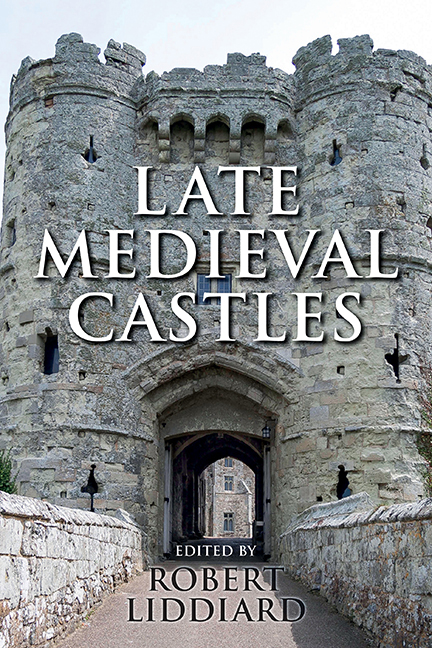Book contents
- Frontmatter
- Contents
- List of Illustrations
- Acknowledgements
- Editor's Preface
- List of Abbreviations
- A Note on the Text
- Introduction
- 1 Fourteenth-Century Castles in Context: Apotheosis or Decline?
- 2 Architects, Advisors and Design at Edward I's Castles in Wales
- 3 The Courtyard and the Tower: Contexts and Symbols in the Development of Late Medieval Great Houses
- 4 Castle Planning in the Fourteenth Century
- 5 Meaningful Constructions: Spatial and Functional Analysis of Medieval Buildings
- 6 Mota, Aula et Turris: The Manor-Houses of the Anglo-Scottish Border
- 7 Lulworth Castle, Dorset
- 8 A Scottish Problem with Castles
- 9 Structural Symbolism in Medieval Castle Architecture
- 10 Specimens of Freedom to Crenellate by Licence
- 11 Some Analysis of the Castle of Bodiam, East Sussex
- 12 English Castles in the Reign Of Edward II
- 13 Castles of Ward and the Changing Pattern of Border Conflict in Ireland
- 14 The Donjon Of Knaresborough: The Castle As Theatre
- 15 The Architecture of Arthurian Enthusiasm: Castle Symbolism in the Reigns of Edward I and his Successors
- 16 Medieval Ornamental Landscapes
- 17 Otherworld Castles in Middle English Arthurian Romance
- Guide to Further Reading
- Index
13 - Castles of Ward and the Changing Pattern of Border Conflict in Ireland
Published online by Cambridge University Press: 29 April 2017
- Frontmatter
- Contents
- List of Illustrations
- Acknowledgements
- Editor's Preface
- List of Abbreviations
- A Note on the Text
- Introduction
- 1 Fourteenth-Century Castles in Context: Apotheosis or Decline?
- 2 Architects, Advisors and Design at Edward I's Castles in Wales
- 3 The Courtyard and the Tower: Contexts and Symbols in the Development of Late Medieval Great Houses
- 4 Castle Planning in the Fourteenth Century
- 5 Meaningful Constructions: Spatial and Functional Analysis of Medieval Buildings
- 6 Mota, Aula et Turris: The Manor-Houses of the Anglo-Scottish Border
- 7 Lulworth Castle, Dorset
- 8 A Scottish Problem with Castles
- 9 Structural Symbolism in Medieval Castle Architecture
- 10 Specimens of Freedom to Crenellate by Licence
- 11 Some Analysis of the Castle of Bodiam, East Sussex
- 12 English Castles in the Reign Of Edward II
- 13 Castles of Ward and the Changing Pattern of Border Conflict in Ireland
- 14 The Donjon Of Knaresborough: The Castle As Theatre
- 15 The Architecture of Arthurian Enthusiasm: Castle Symbolism in the Reigns of Edward I and his Successors
- 16 Medieval Ornamental Landscapes
- 17 Otherworld Castles in Middle English Arthurian Romance
- Guide to Further Reading
- Index
Summary
Throughout the Middle Ages, on any definition of that term, Ireland was a land of borders. Competing early medieval kingdoms were followed by the incursion of lords owing allegiance to the English king who never succeeded in controlling the whole land. We find the term, the March, being used from the time of King John, and so too was the term ‘the land of war’, to be contrasted with the land of peace. The terms came from Wales, but the two countries were different; there was no such thing in Ireland as March law, nor was there a group of baron distinguishable from their fellows by holding land in the March.
We must stress that in Ireland we are not looking at a single border, but at many individual borders, between different lordships, English and Irish. Inevitably the response to the question of control of these borders will have varied through both space and time. In terms of the archaeology, we may distinguish between three sorts of buildings: earthworks, predominantly mottes; castles of ward, and tower houses. It should be stressed that we are talking here about responses to situations, not necessarily about systems; these may simply be tendencies to be picked out, not clear-cut types.
The early phase of this evolution has already been discussed: a considerable increase of motte building (with more baileys) along the frontier as it developed. Only some of the English lordships erected a border screen of mottes. This is partly a measure of the threat they perceived, greater for Meath, Oriel and Ulster than for Munster or Leinster. Not all borders were considered the same, and militarisation, constructing many mottes, was not always worth the effort involved. I wish, however, in this paper to concentrate on the next period, covering the bulk of the thirteenth and fourteenth centuries. Here we may see two sorts of castles on the borders. One is a major stronghold, a first-rate castle in Irish terms at least, in the area concerned: the other is the building of castles of ward, lesser enclosures to be manned by small, temporary garrisons. The former are not true border castles, but mark attempts to expand lordships to new areas.
- Type
- Chapter
- Information
- Late Medieval Castles , pp. 323 - 332Publisher: Boydell & BrewerPrint publication year: 2016



